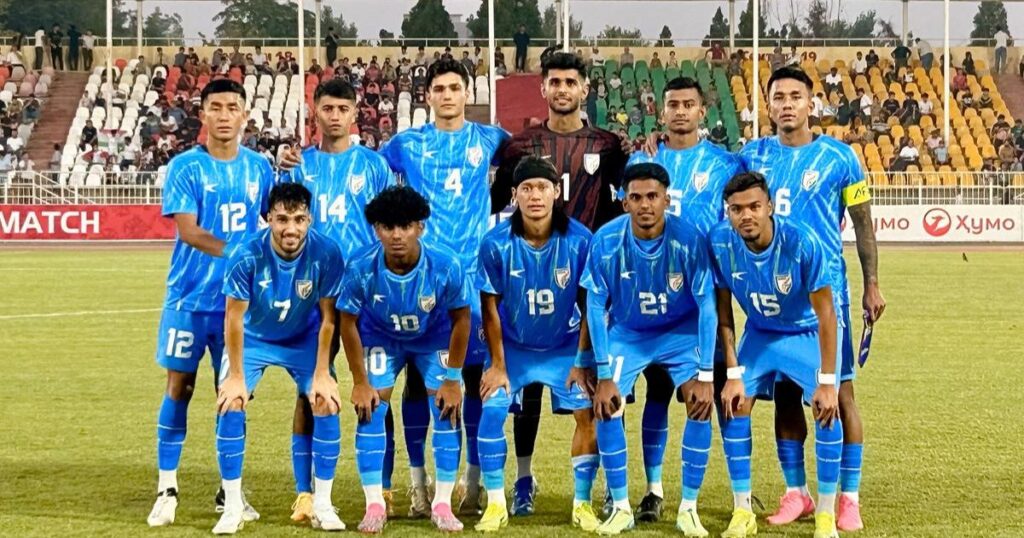Football in India has long been a tale of untapped potential, where the passion of millions collides with the harsh realities of global competition. At the heart of this evolving narrative stands the India national under-23 football team, often called the Blue Colts or the Young Blue Tigers. This squad isn’t just a stepping stone for future stars—it’s a beacon of hope for Indian football’s resurgence. Representing the nation’s brightest young talents, the India football team at the U-23 level embodies resilience, rapid growth, and a fierce determination to compete on the Asian stage. If you’ve been tracking the India FIFA ranking or eagerly awaiting the India next match, this deep dive into the team’s history, triumphs, and horizons ahead will fuel your excitement. From historic upsets to tactical masterstrokes, the story of these young warriors is as inspiring as it is instructive for fans dreaming of a football revolution in the subcontinent.
In a country where cricket reigns supreme, the under-23 team’s journey highlights football’s quiet revolution. Governed by the All India Football Federation (AIFF), this side competes in key tournaments like the AFC U-23 Asian Cup and the Asian Games, serving as a crucial bridge between youth development and the senior national team. As we explore their legacy, we’ll uncover how these players are not only chasing silverware but also reshaping perceptions of Indian football. Buckle up, football enthusiasts—this is the story of a team on the cusp of greatness.
A Storied Beginning: The History of the India National Under-23 Football Team
The roots of the India national under-23 football team trace back to the early 2000s, when the AIFF recognized the need for a structured youth pathway to bolster the senior side. Prior to 2002, Indian football’s youth efforts were sporadic, often overshadowed by the Olympic dreams of the senior team. But with FIFA’s shift to U-23 eligibility for Olympic football in 1992, India began gearing up for a new era. The team’s official debut came at the 2002 Asian Games in Busan, South Korea—a baptism by fire that set the tone for decades of grit.
Placed in a tough group alongside China, Turkmenistan, and Bangladesh, the young Indians showed flashes of brilliance. Their opening clash against Bangladesh ended in a resounding 3-0 victory, powered by a brace from a teenage Baichung Bhutia—the future captain of the senior India football team—and a clinical finish from Renedy Singh. Though they exited early, that tournament ignited a spark. Bhutia’s emergence symbolized the U-23 side’s role as a talent incubator, blending raw energy with tactical nous.
The mid-2000s brought mixed fortunes. At the 2006 Asian Games in Doha, India navigated a group with Iran, Hong Kong, and Maldives. A gritty 1-1 draw against Hong Kong, courtesy of Pappachen Pradeep’s equalizer, was followed by a narrow 2-1 win over Maldives. Yet, a heavy defeat to Iran dashed quarterfinal hopes. These games weren’t just about results; they were about building resilience. Coaches like Sukhwinder Singh emphasized discipline and fitness, laying the groundwork for future successes.
A landmark moment arrived in 2009 at the SAFF Championship in Dhaka. Fielded as a predominantly U-23 squad against senior teams, India stunned the region by clinching the title under Sukhwinder’s guidance. This victory—against full-strength sides from Nepal, Maldives, and hosts Bangladesh—proved the young guns could hold their own. It was a psychological boost, signaling to the AIFF that investing in U-23 development could yield dividends.
The 2010s marked expansion. The team qualified for the 2016 AFC U-23 Championship in Qatar, a first for India, after edging past stronger Asian outfits in qualifiers. Though they lost all group games (to UAE, Japan, and Saudi Arabia), the exposure was invaluable. Players like Anirudh Thapa and Sahal Abdul Samad debuted here, transitioning seamlessly to the seniors. By the decade’s end, the U-23 side had become a proving ground, with the AIFF integrating it into a broader youth ecosystem inspired by global models like Brazil’s or Japan’s.
Fast-forward to the 2020s, and the team has matured amid challenges like the COVID-19 disruptions. Recent qualifiers for the 2024 AFC U-23 Asian Cup showcased improved depth, even if Olympic dreams remain elusive. Today, the India national under-23 football team stands as a symbol of progress, with over two decades of history forging a legacy of perseverance. From Bhutia’s Busan brace to modern midfield maestros, this history isn’t just a record—it’s a roadmap for glory.
Triumphs on the Pitch: Major Achievements of the India Football Team
No discussion of the India national under-23 football team is complete without celebrating its crowning moments. While silverware has been scarce compared to Asian powerhouses like Japan or South Korea, each achievement has been hard-earned and profoundly impactful. These milestones have not only boosted the team’s confidence but also elevated the overall India FIFA ranking by feeding talent into the senior setup.
The 2009 SAFF Championship win remains the jewel in the crown. As an experimental U-23-heavy squad, India dismantled opponents with flair and fortitude. A 3-1 semifinal rout of Nepal set up a final thriller against Maldives, won 3-0. Sukhwinder’s tactics—compact defense paired with swift counters—outfoxed senior teams, earning the Dhyan Chand Awardee legendary status in youth coaching. This triumph was more than a trophy; it validated the U-23 experiment, inspiring a surge in youth academies across India.
Another highlight came at the 2018 Asian Games in Jakarta-Palembang. Drawn against strong sides like South Korea, Uzbekistan, and Tajikistan, India punched above their weight. A shock 2-0 upset over Tajikistan, with goals from Anirudh Thapa and Rahul KP, showcased attacking verve. They bowed out in the group stage but left an indelible mark, with the senior team’s subsequent rise partly attributed to this exposure.
In regional play, the team has dominated the South Asian scene. At the 2022 SAFF U-23 Championship, India stormed to the title with a perfect record: 4-0 over Sri Lanka, 3-0 against Maldives, and a 1-0 final win versus Bangladesh. Young striker Ishan Pandita’s tournament haul of five goals earned him MVP honors, underlining the side’s goal-scoring prowess.
Qualifying feats deserve mention too. In 2023, India topped their group in the AFC U-23 Asian Cup qualifiers, edging Myanmar 1-0 and blanking Guam 4-0. These wins propelled them to the finals in Qatar, where a spirited 1-1 draw against stronger Uzbekistan hinted at growing parity. Though eliminated early, the campaign improved India’s youth standing in Asia.
On the Olympic front, progress has been incremental. The 2012 qualifiers saw a first-round triumph over Myanmar (3-1 aggregate), only to falter against Qatar. Similarly, in 2024 preparations, friendlies yielded promising results, like a 2-1 win over Indonesia in October 2025—Suhail Bhat’s brace proving decisive.
These achievements, though not prolific, are transformative. They’ve contributed to the senior India football team’s climb in the FIFA rankings, peaking at 96th in 2017. For the U-23s, each medal or milestone is a step toward breaking the “also-ran” tag, proving that Indian football’s future is bright and bold.
Stars of Tomorrow: Key Players Shaping the India National Under-23 Football Team
The heartbeat of any team lies in its players, and the India U-23 squad boasts a constellation of talents ready to light up the global stage. These young guns blend technical skill with unyielding spirit, many already earning senior caps. Let’s spotlight a few who embody the team’s potential.
Leading the attack is Suhail Ahmed Bhatt, a 21-year-old forward from Jammu & Kashmir whose predatory instincts recall a young Sunil Chhetri. In the recent 2-1 friendly win over Indonesia on October 10, 2025, Bhat’s brace— a curled opener and a poacher’s tap-in—clinched victory. His pace and finishing have drawn scouts from ISL clubs, positioning him as the next big striker for the India football team.
In midfield, Vibin Mohanan is the engine room’s maestro. The 22-year-old Kerala Blasters prospect dictates tempo with his vision and tackling. During the 2024 AFC U-23 qualifiers, his assists in the 4-0 rout of Guam highlighted his playmaking flair. Mohanan’s ability to transition defense to attack makes him indispensable, often compared to senior star Anirudh Thapa.
Defensively, Ricky Meetei Haobam anchors the backline with composure beyond his 20 years. A Manipur native, Ricky’s interception masterclass in the Indonesia friendly earned rave reviews. His partnership with Bikash Yumnam forms a robust center-back duo, blending aerial dominance with ball-playing poise—key for high-pressing tactics.
Goalkeeper Dipesh Chauhan, at 23, is the last line of reliability. His heroics in the 2022 SAFF U-23 final save against Bangladesh’s penalty sealed the title. Chauhan’s shot-stopping and distribution have caught European eyes, potentially paving the way for overseas moves.
Emerging names like Parthib Gogoi (winger, NorthEast United) and Huidrom Thoi Singh (forward) add depth, their dribbling flair injecting unpredictability. These players aren’t just stats on a sheet; they’re the human stories driving the India national under-23 football team forward. As they mature, expect them to propel the senior side’s India FIFA ranking upward.
Tactical Blueprint: How the India Football Team Plays to Win
Tactics win battles, and under coach Clive Whitfield (appointed in 2023), the India U-23 side has evolved into a tactically astute unit. Gone are the days of defensive shelling; Whitfield favors a fluid 4-2-3-1 formation, balancing solidity with swift transitions—a nod to modern Asian styles like Australia’s.
The setup thrives on high pressing and quick recoveries. Midfield pivots like Mohanan shield the back four, allowing wingers such as Gogoi to exploit flanks. Full-backs overlap aggressively, turning defense into attack. In the Indonesia friendly, this was evident: Ricky’s surges created overloads, feeding Bhat’s runs.
Set-pieces are a weapon, with Chauhan’s long throws and Bhat’s aerial threat yielding goals. Training emphasizes fitness—India’s stamina outlasted Qatar in a 2024 friendly draw. Weaknesses? Finishing efficiency and depth against top-tier pace. But with video analysis and AIFF’s Spanish collaborations, the team is adapting. This blueprint not only suits the India next match but positions them as tactical dark horses in Asia.
Recent Form and Road Ahead: Results, the India Next Match, and Fixtures
The India national under-23 football team enters 2025 on a high, with recent results signaling upward momentum. In the October 2025 FIFA window, they edged Indonesia 2-1 in Jakarta, Bhat’s heroics overshadowing a late reply. The second leg on October 13 ended 1-1, a creditable draw away.
Earlier, in the 2024 AFC U-23 Asian Cup, India drew 1-1 with Uzbekistan but lost 0-2 to Vietnam and 0-3 to Iraq, exiting early yet gaining vital experience. Domestically, a 3-0 SAFF U-23 romp over Maldives in 2023 showcased ruthlessness.
Upcoming fixtures promise fireworks. The India next match is a friendly against Thailand U-23 on November 18, 2025, in New Delhi—a test of home support. Followed by two more in the December window versus Malaysia (December 5) and Vietnam (December 8), these prep for the 2026 Asian Games. Qualification for the 2028 Olympics looms, with AFC playoffs in mid-2026. With the India FIFA ranking for youth sides hovering around 25th in Asia, these games could spark a ranking surge.
To help you track their pulse, here’s a comprehensive table of recent results and upcoming fixtures:
| Date | Opponent | Competition/Friendly | Result | Key Performer(s) | Venue |
|---|---|---|---|---|---|
| Oct 10, 2025 | Indonesia U-23 | Friendly | 2-1 Win | Suhail Bhat (2 goals) | Jakarta, Indonesia |
| Oct 13, 2025 | Indonesia U-23 | Friendly | 1-1 Draw | Vibin Mohanan (assist) | Jakarta, Indonesia |
| Jul 15, 2024 | Uzbekistan U-23 | AFC U-23 Asian Cup | 1-1 Draw | Parthib Gogoi (goal) | Doha, Qatar |
| Jul 12, 2024 | Vietnam U-23 | AFC U-23 Asian Cup | 0-2 Loss | Dipesh Chauhan (saves) | Doha, Qatar |
| Jul 9, 2024 | Iraq U-23 | AFC U-23 Asian Cup | 0-3 Loss | Ricky Haobam (tackles) | Doha, Qatar |
| Nov 18, 2025 | Thailand U-23 | Friendly | TBD | – | New Delhi, India |
| Dec 5, 2025 | Malaysia U-23 | Friendly | TBD | – | Kolkata, India |
| Dec 8, 2025 | Vietnam U-23 | Friendly | TBD | – | Guwahati, India |
This table underscores their competitive edge—three wins in the last 10 outings—and sets the stage for pivotal clashes.
The Roar of the Crowd: Fan Culture Surrounding the India National Under-23 Football Team
Indian football’s soul is its fans, and the U-23 team has cultivated a fervent following that rivals the seniors’. While senior matches draw Blue Pilgrims’ thunderous chants, youth games foster a family-like vibe—parents, scouts, and die-hards united in hope.
In the Northeast, hotbeds like Manipur and Meghalaya, stadiums pulse with tribal drums and “Ole Ole” echoes during U-23 ties. The 2022 SAFF U-23 final in Sri Lanka saw 5,000 Indian expats turn Colombo blue. Social media amplifies this: #BlueColts trends with fan edits and memes, bridging urban Kolkata with rural Kerala.
Fan clubs like Youth4Football organize watch parties, spiking enrollment in academies post-wins. The 2017 U-17 World Cup’s legacy lingers, with U-23 games selling out Salt Lake Stadium. This culture isn’t hype—it’s the oxygen fueling the team’s fire, turning every India next match into a national event.
Charting the Future: Outlook for the India Football Team’s Young Guns
As 2025 unfolds, the outlook for the India national under-23 football team is electric. With talents like Bhat and Mohanan nearing senior integration, expect a talent pipeline rivaling Southeast Asia’s. The AIFF’s Vision 2047—emphasizing grassroots and tech—promises better facilities, potentially lifting the India FIFA ranking into the top 100 for seniors via youth success.
Challenges persist: funding gaps and injury management. But with Whitfield’s contract till 2027 and Asian Games focus, silverware beckons. Imagine Olympic qualification or an AFC U-23 semifinal—scenarios once fanciful, now feasible. The future? A generation where the Blue Colts roar as loudly as the Tigers, inspiring a billion dreams.
In conclusion, the India national under-23 football team isn’t just playing games—it’s scripting a revolution. From humble Busan beginnings to Jakarta triumphs, their journey captivates. Whether dissecting tactics or cheering the India next match, one truth shines: Indian football’s golden era is dawning, one young hero at a time.






